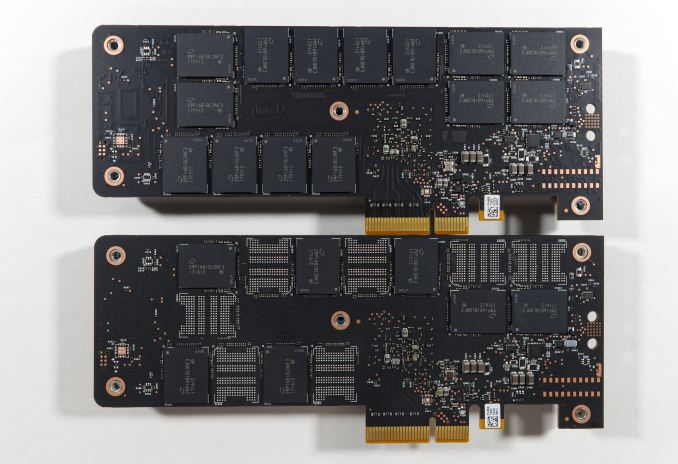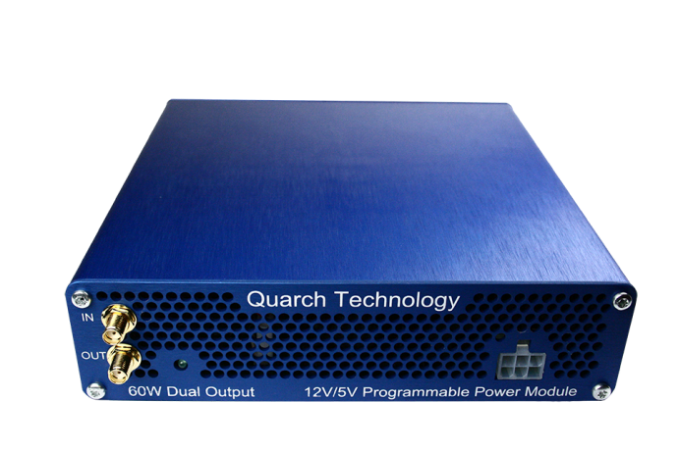The Intel Optane SSD 900p 480GB Review: Diving Deeper Into 3D XPoint
by Billy Tallis on December 15, 2017 12:15 PM EST
Our first look at the Intel Optane SSD 900p only included the smaller 280GB capacity. We now have added the 480GB model to our collection, and have started analyzing the power consumption of the fastest SSDs on the market.
This second look at the Optane SSD 900p doesn't change the overall picture much. As we speculated in our initial review, the design of the Optane SSD and its 3D XPoint memory means that performance does not scale with capacity the way most flash-based SSD designs do. The Optane SSD 900p uses a controller with seven channels for communicating with the 3D XPoint memory. The difference between the 280GB and 480GB models is merely a difference of three or five 3D XPoint dies per channel. Of the 28 memory package locations on the PCB, the 280GB model populates 21 with single die packages. The 480GB model uses all 28 spots, and half of the packages on the front are dual-die packages.
A single NAND flash die isn't enough to keep one of the controller's channels busy, because flash takes many microseconds to complete a read or write command, and even longer for erase commands. By contrast, 3D XPoint memory is fast enough that there is little to no performance to be gained from overlapping commands to multiple dies on a single channel. Increasing the number of dies per channel on an Optane SSD affects capacity and power consumption but not performance.
Intel recently let slip the existence of 960GB and 1.5TB versions of the 900p, through the disclosure of a product change notification about tweaks to the product labeling. The specifications for the larger capacities have not been confirmed but likely match the smaller models in every respect except power consumption. Since Intel has not officially announced the higher capacities yet, no MSRP or release date is available.
| Intel Optane SSD 900P Specifications | ||||
| Capacity | 280 GB | 480 GB | 960 GB | 1.5 TB |
| Controller | Intel SLL3D | |||
| Memory | Intel 128Gb 3D XPoint | |||
| Interface | PCIe 3.0 x4 | |||
| Form Factor | HHHL Add-in card or 2.5" 15mm U.2 |
HHHL Add-in card | HHHL Add-in card (U.2 unknown) |
|
| Sequential Read | 2500 MB/s | TBD | ||
| Sequential Write | 2000 MB/s | TBD | ||
| Random Read IOPS | 550k | TBD | ||
| Random Write IOPS | 500k | TBD | ||
| Power Consumption | 8W Read 13W Write 14W Burst 5W Idle |
<20.5 W | <24 W | |
| Write Endurance | 10 DWPD | TBD | ||
| Warranty | 5 years | TBD | ||
| Recommended Price | $389 ($1.39/GB) | $599 ($1.25/GB) | TBD | TBD |
Our SSD power measurement equipment burned out right before our first Optane SSD arrived. As of this week, we have newer and much better power measurement equipment on hand: a Quarch XLC Programmable Power Module. We'll explore its capabilities more in a future article. For now, we're filling in the missing power measurements from the past several reviews. Both of the Optane SSD 900p models have been re-tested with the Quarch power module on the entire test suite except for The Destroyer (so far). We haven't yet thoroughly validated the new power measurements against the results from our old meter so there may be some discrepancies, but the Optane SSDs draw so much power that any minor differences won't matter to this review. Everything that was tested with the old meter will eventually be re-tested on the Quarch power module, but we don't expect significant changes except to idle power measurements (where the Quarch power module should offer higher resolution).
Our first review of the Optane SSD 900p included a few puzzling results, most notably slightly higher performance when the ATSB Heavy and Light tests were run on a filled drive than when the Optane SSDs were freshly erased. One potential factor for this has since come to light: After first being powered on, Intel Optane SSDs perform a background data refresh process. This isn't necessary unless the SSD has been powered off for a long time, but the drive has no way to know how long it was without power. The documentation for the 750GB Optane SSD DC P4800X states this process can take up to three hours. We have not observed any clear transition in idle power during the first few hours after power-on, but there are occasional short periods where idle power drops by around 350-400mW (from around 3.5W).
Without a conclusive indication of whether background data refresh is happening and influencing benchmark results, we've re-tested the 280GB Optane SSD 900p for this review. Before running the synthetic benchmarks, the 900p was allowed to sit at idle for at least three hours. The ATSB tests were also conducted after an extended idle period, but the test system was rebooted between ATSB tests. Even with this precaution, there's still significant variability between test runs on the Optane SSD 900p and the full-drive performance is often better than freshly erased, so it appears there's another factor contributing to this behavior.
| AnandTech 2017 SSD Testbed | |
| CPU | Intel Xeon E3 1240 v5 |
| Motherboard | ASRock Fatal1ty E3V5 Performance Gaming/OC |
| Chipset | Intel C232 |
| Memory | 4x 8GB G.SKILL Ripjaws DDR4-2400 CL15 |
| Graphics | AMD Radeon HD 5450, 1920x1200@60Hz |
| Software | Windows 10 x64, version 1703 |
| Linux kernel version 4.12, fio version 2.21 | |
- Thanks to Intel for the Xeon E3 1240 v5 CPU
- Thanks to ASRock for the E3V5 Performance Gaming/OC
- Thanks to G.SKILL for the Ripjaws DDR4-2400 RAM
- Thanks to Corsair for the RM750 power supply, Carbide 200R case, and Hydro H60 CPU cooler
- Thanks to Quarch for the XLC Programmable Power Module and accessories












69 Comments
View All Comments
nathanddrews - Friday, December 15, 2017 - link
Is there any indication that performance would degrade with a lesser CPU or improve with a faster CPU? Just curious if we should expect CPU bottlenecks from these hyper-speed SSDs.Billy Tallis - Friday, December 15, 2017 - link
Yes, CPU speed can definitely affect latency and consistency and maximum achievable IOPS. Some of those limits were hit with the P4800X testing on a server with lower per-core performance than this consumer testbed.At the moment, my inclination is to leave the consumer test suite single-threaded, because consumer workloads don't actually hit the queue depths necessary to go beyond the I/O capabilities of a single CPU core. I don't care too much if the high QD range on some of the graphs doesn't quite reach the theoretical limit of the drive, because that's not the part of the graph we should be paying attention to. (For consumer drives.)
At low queue depths, interrupt servicing latency can be helped a bit by a faster CPU. But for most consumers, switching from Windows to Linux will do a lot more to help reduce their storage latency. And saving a few more microseconds only matters on Optane; mainstream products won't be this fast for quite a while.
ddrіver - Friday, December 15, 2017 - link
I think I'll have to reevaluate my position on Optane. Seems like a solid product. Guess I misread the signs.ddriver - Friday, December 15, 2017 - link
How can you tell a fake "ddriver" apart? Well, the real one would never mislabel the product hypetane ;)It is what it is, and still nowhere nearly "1000x" better as intel claimed. It has its niche strengths, but those offer no tangible benefit to 99.9999% of the consumers out there. I don't recall ever claiming that it will suck, my claim has always been that it will epically fail to live up to the hype, which testing thoroughly confirms. It is not even 10% of "1000x better". So hypetane it is.
SLC flash can easily match and even bet it in most performance metrics. Unfortunately the industry is not even trying, even mlc is now considered "ultra high end enterprise". Which is understandable, as the workloads that could actually benefit from higher performance are very few and far in between, and for 99% of them using ram is the more applicable and still tremendously better performing solution.
It is definitely not a bad product on its own. And I would not refer to it as "hypetane" if only intel hadn't shamelessly lied about it on such a preposterous scale.
tuxRoller - Friday, December 15, 2017 - link
Interface speeds≠ media speedsWhen will you learn?
Also, still need a reference for those SLC numbers.
LordanSS - Saturday, December 16, 2017 - link
Indeed, Interface speeds are not "media" speeds. I never expected it to work according to Intel's "1000x" claims, but was hoping for a more in-line 20x better from what we currently have, considering first generation product and all.And it doesn't even do that. Sorry, for this one time, I am (partially) siding with ddriver.
lmcd - Saturday, December 16, 2017 - link
20X better overall is entirely unrealistic. Certain attributes are 20X better. That is all you can really expect when so many things (form factor, power usage, interface protocols, physical interface, etc) are retained from the previous generation.LordanSS - Sunday, December 17, 2017 - link
20x is 2% (TWO PERCENT) of what Intel claimed when they disclosed XPoint. It's not realistic?Intel shoul have kept their mouth shut back then, just like Micron has done so until now. If they can't even do 2% of what they claimed, they're the unrealistic ones.
tuxRoller - Sunday, December 17, 2017 - link
Were those claims that Intel made in reference to xpoint the tech, or optane the first gen product?tuxRoller - Saturday, December 16, 2017 - link
I'm not sure why you are quoting media, but you are absolutely welcome to be disappointed.You'll notice I don't care whether anyone thinks Intel over hyped their product only that we still don't know what the actual xpoint (the media, or "tread + xfer + Misc" times, as Handy refers to it) response times look like.
If AT doesn't allow the below link, search for "xpoint presence in slow lane explained" on the register, or Google "Why XPoint SSDs won't meet original speed claims: A guide"
https://www.theregister.co.uk/2016/09/29/xpoint_pr...